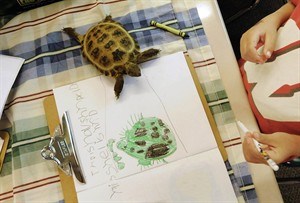
In this Sept. 11, 2012, photo, a tortoise walks onto the coloring project of a tortoise by Gavin Thoen in the first grade classroom of Dawn Slinger in Farmington, Minn. When the school year is over, each student's work becomes a book. Maryland-based Pets in the Classroom project is offering grants to help teachers pay for pets, cages, tanks and supplies of food. It issued its 10,000th grant this summer. (AP Photo/Jim Mone)
September 18, 2012 - 4:02 AM
LOS ANGELES, Calif. - For many children, their first pet is a virtual one.
Experts say many children who enter the first grade can play video games but few have a pet to play with. And teachers say that's a shame, considering how animals — real ones — can enrich a child's upbringing.
So for a quarter of a century, educators such as Dawn Slinger in Farmington, Minn., have paid out of their own pockets to provide one for their classrooms. Only in the past few years have groups stepped in to help with the financial burden.
Two years ago, Pets in the Classroom, a Maryland-based project from the non-profit foundation Pet Care Trust, began offering grants to U.S. and Canadian teachers in grades 1 through 8. The money can be used to buy starter pets, cages, food and other supplies. It issued its 10,000th grant this summer.
The $150 grants help offset the cost of the animal and its care, which helps teachers like Slinger who has been using her own money, said foundation executive director Steve King. Just an aquarium for a frog could cost more than a hundred dollars.
Teachers who apply for a second year or more get $50 for additional equipment, food and supplies.
Pet Care Trust first started introducing pets to classrooms through a joint venture with the Florida Aquarium in Tampa five years ago. A classroom fish project gave participating teachers a 150-gallon aquarium, supplies and fish, King said. Nearly 200 classrooms in the Tampa area got aquariums, and a similar program was started in Chicago.
Slinger believes the cost is worth the experience for her students. She builds lessons around two miniature Russian tortoises, a fire-belly newt, tree frogs, three types of gecko, several hermit crabs, two small ball pythons, a corn snake and a 45-gallon tank of fish. Students observe and draw the animals, and research and write about them. When the school year is over, each student's work becomes a book.
Parents tell her their children are inspired by the animals and are excited about learning, she said.
She said that out of a class of children — hers last year had 26 — "maybe six will have pets at home, usually a cat or dog. Not many will have reptiles." Since taking her class, "several students have gotten hermit crabs or fish for their houses. One got a lizard and one is working on a snake."
The decision over what kind of pet to get lies with the teacher. Slinger chose hers because they fascinate children, their temperaments are right and they don't bother students with allergies or asthma, she said.
Concerns from parents over disease, allergies and exposure to waste have led to bans or limits on animals in some classrooms, although service animals are allowed in most schools. The Pet Care Trust leaves it to the teachers to know their students and parents, and King said teachers and students must follow cleanliness guidelines.
Among applications for first-time grants, the most popular choices for classroom pets were small mammals, like hamsters, guinea pigs, rats and rabbits, King said. That was followed by aquarium pets, reptiles and amphibians, then birds, he said.
Classroom pets also have been enlightening for some families. Heidi Keating said her 8-year-old son Wayne has been begging for a snake since he was in Slinger's class last year.
"First, I said absolutely no. Then Wayne said, 'Come see the snakes in class.' Even Grandma came. We petted it. I never knew they were soft. I am a little more open at this point," she said.
Keating said the family wants to encourage his interest, so they took Wayne to a reptile zoo for his birthday.
"It helps me get over my fears too," she said. "I am learning. I am honest about it, and he knows I am coming along with it. His (5-year-old) sister Quincy is too. When she had her face painted, she wanted a snake."
But until Wayne is a little older, he'll have to settle for the 4-month-old basset hound puppy the Keatings got recently.
Classroom pets also can be incentives for good grades, as when some teachers allow students to care for the animals when school is out, King said. Slinger visits her classroom pets two or three times a week during summers and vacations.
As for the animals that don't return for another school year, that's a learning moment too, King said.
"Lifespan is part of the life lesson that comes with having a classroom pet," he said.
___
Online:
http://www.petsintheclassroom.org
News from © The Associated Press, 2012